| |||||
| Decades: | |||||
|---|---|---|---|---|---|
| See also: | |||||
Events in the year 2001 in Bulgaria .
| |||||
| Decades: | |||||
|---|---|---|---|---|---|
| See also: | |||||
Events in the year 2001 in Bulgaria .
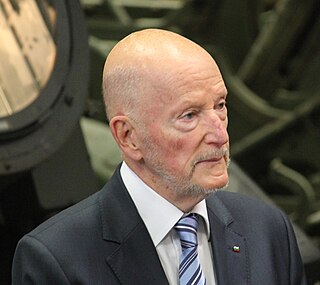
Simeon Borisov von Saxe-Coburg-Gotha is a Bulgarian politician who reigned as the last tsar of the Kingdom of Bulgaria as Simeon II from 1943 until 1946. He was six years old when his father Boris III of Bulgaria died in 1943 and royal power was exercised on his behalf by a regency council led by Simeon's uncle Kiril, Prince of Preslav, General Nikola Mihov and prime minister, Bogdan Filov. In 1946 the monarchy was abolished by referendum, and Simeon was forced into exile.

Tsar SimeonI the Great ruled over Bulgaria from 893 to 927, during the First Bulgarian Empire. Simeon's successful campaigns against the Byzantines, Magyars and Serbs led Bulgaria to its greatest territorial expansion ever, making it the most powerful state in contemporary Eastern and Southeast Europe. His reign was also a period of unmatched cultural prosperity and enlightenment later deemed the Golden Age of Bulgarian culture.

The National Movement for Stability and Progress is a liberal, populist political party in Bulgaria. It was known as the National Movement Simeon II until 3 June 2007.
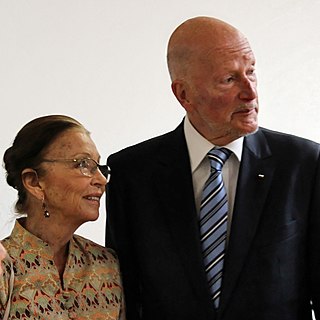
Margarita Gómez-Acebo y Cejuela is the wife of Tsar Simeon II of Bulgaria, whom she married after he went into exile. As such, she is also sometimes styled Tsaritsa Margarita; in this context, she may be styled as Princess of Saxe-Coburg and Gotha and Duchess in Saxony, due to her husband's descent from those former ruling families. During her husband's tenure as Prime Minister of Bulgaria, she was sometimes referred as Margarita Sakskoburggotska. The current Bulgarian government does not recognize the titles in exile of the former Bulgarian royal family.
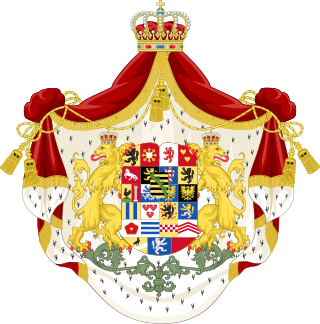
The House of Saxe-Coburg and Gotha is a European royal house. It takes its name from its oldest domain, the Ernestine duchy of Saxe-Coburg and Gotha, its members later sat on the thrones of Belgium, Bulgaria, Portugal, and the United Kingdom and its dominions.
Pope Simeon II of Alexandria, 51st Pope of Alexandria and Patriarch of the See of St. Mark.

In 926 a battle was fought in the Bosnian highlands between the armies of the Bulgarian Empire, under the rule of Bulgarian Tsar Simeon I, who at the time also fought a war with the Byzantine Empire, and the Kingdom of Croatia under Tomislav, the first king of the Croatian state. The battle is also known as the Battle of the Bosnian Highlands. It was fought in the Dinaric Alps of Eastern Bosnia near the rivers Bosna and Drina, the border area between the Kingdom of Croatia and the Bulgarian Empire.
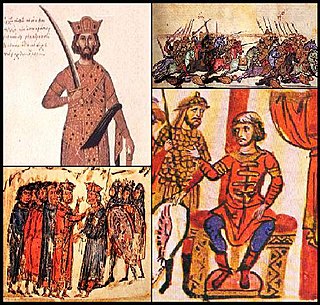
The Byzantine–Bulgarian wars were a series of conflicts fought between the Byzantines and Bulgarians which began after the founders of Bulgaria settled in the Balkan peninsula in the 670s, and intensified with the expansion of the Bulgarian Empire to the southwest after 681 AD. The Byzantines and Bulgarians continued to clash over the next century with variable success, until the Bulgarians, led by Krum, inflicted a series of crushing defeats on the Byzantines. After Krum died in 814, his son Omurtag negotiated a thirty-year peace treaty. Simeon I had multiple successful campaigns against the Byzantines during his rule from 893 to 927. His son Peter I negotiated another long-lasting peace treaty. His rule was followed by a period of decline of the Bulgarian state.
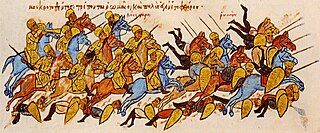
The Battle of Boulgarophygon or Battle of Bulgarophygon was fought in the summer of 896 near the town of Bulgarophygon, modern Babaeski in Turkey, between the Byzantine Empire and the First Bulgarian Empire. The result was an annihilation of the Byzantine army which determined the Bulgarian victory in the trade war of 894–896.

Simeon Dyankov is a Bulgarian economist. From 2009 to 2013, he was the deputy prime minister and minister of finance of Bulgaria in the government of Boyko Borisov. He has been a vocal supporter of Bulgaria's entry into the Eurozone. Before his cabinet appointment, he was the chief economist of the finance and private sector vice-presidency of the World Bank.

GERB, is a conservative, populist political party which was the ruling party of Bulgaria between 2009-2013 and 2016-2021.
The Battle of Pegae was fought between 11 and 18 March 921 in the outskirts of Constantinople between the forces of the Bulgarian Empire and the Byzantine Empire during the Byzantine–Bulgarian war of 913–927. The battle took place in a locality called Pegae, named after the nearby Church of St. Mary of the Spring. The Byzantine lines collapsed at the very first Bulgarian attack and their commanders fled the battlefield. In the subsequent rout most Byzantine soldiers were killed by the sword, drowned or were captured.

The Bulgarian-Serbian wars were a series of conflicts between the Bulgarian Empire and medieval Serbian states between the 9th and 14th centuries in the central Balkans.

Simeon Nenchev Slavchev is a Bulgarian professional footballer who plays as a defensive midfielder for Wieczysta Kraków.
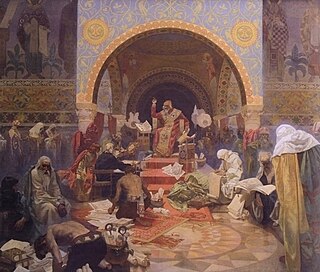
Tsar, also spelled czar, tzar, or csar, was a title used by Slavic monarchs. The term is derived from the Latin word caesar, which was intended to mean "emperor" in the European medieval sense of the term—a ruler with the same rank as a Roman emperor, holding it by the approval of another emperor or a supreme ecclesiastical official —but was usually considered by Western Europeans to be equivalent to "king". It lends its name to a system of government, tsarist autocracy or tsarism.

The Byzantine–Bulgarian war of 894–896 was fought between the Bulgarian Empire and the Byzantine Empire as a result of the decision of the Byzantine emperor Leo VI to move the Bulgarian market from Constantinople to Thessalonica which would greatly increase the expenses of the Bulgarian merchants.
The Byzantine–Bulgarian war of 913–927 was fought between the Bulgarian Empire and the Byzantine Empire for more than a decade. Although the war was provoked by the Byzantine emperor Alexander's decision to discontinue paying an annual tribute to Bulgaria, the military and ideological initiative was held by Simeon I of Bulgaria, who demanded to be recognized as Tsar and made it clear that he aimed to conquer not only Constantinople but the rest of the Byzantine Empire, as well.
The Battle of Constantinople was fought in June 922 at the outskirts of the capital of the Byzantine Empire, Constantinople, between the forces of the First Bulgarian Empire and the Byzantines during the Byzantine–Bulgarian war of 913–927. In the summer the Byzantine Emperor Romanos I Lekapenos sent troops under the commander Saktikios to repel another Bulgarian raid at the outskirts of the Byzantine capital. The Byzantines stormed the Bulgarian camp but were defeated when they confronted the main Bulgarian forces. During his flight from the battlefield Saktikios was mortally wounded and died the following night.
Events in the year 2005 in Bulgaria.
Events in the year 1943 in Bulgaria.